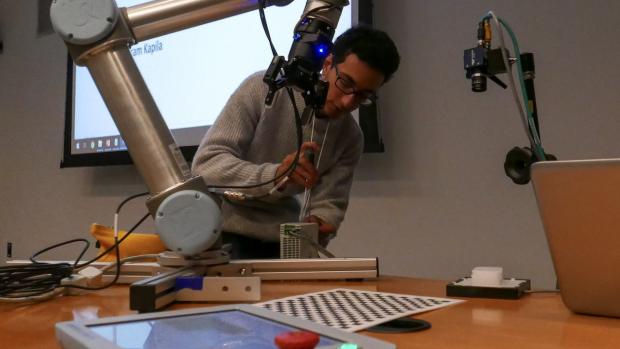How It’s Made Easier: Tandon Robotics Lab Supports NYC-Based Manufacturers

Joseph Abdemalak of Axis Inc. demonstrates the collaborative robot, or corobot.
“Swarm” robotics sounds like the stuff of science fiction, but it may actually be the future of the manufacturing industry. As NYU Tandon Professor Vikram Kapila told the group of manufacturing professionals gathered for the summer’s third OPS21 Robotics Awareness Workshop, swarm systems make integrating robotics into an industrial workplace safer and more efficient. Using LiDAR, robots that are part of a “swarm” on a manufacturing or warehouse floor can identify not only human workers and obstacles around them, but also each other.
What’s more, adds Professor Kapila, “Using these kind of robots has become easier and more cost-effective given advancements in cheaper sensors, embedded computing, and machine learning.” Other advancements, in areas like blockchain technology, allow robots in obstacle-ridden industrial settings to gain global awareness using minimal sensing and distributed computing.
Professor Kapila spoke at last week’s OPS21 workshop to manufacturing professionals, sharing the benefits of using robotics in industrial settings. OPS21, part of Futureworks NYC, is a series of meetings taking place this summer and fall to help New York City-area manufacturers better understand and identify emerging technologies that can optimize operations and increase business competitiveness. The robotics awareness workshop focused on demonstrating the power and utility of robots that can perform tasks deemed tedious, repetitive, or too dangerous for human workers. The workshop served as an introduction to manufacturers who are considering using automation, mechatronics, or robotics in their factories or warehouses, but who may not yet know where to begin. Professor Kapila’s presentation on the benefits of automation and robotics was complemented by a demonstration of a PUMA (Programmable Universal Machine for Assembly) cobot, short for a collaborative robot, endowed with image recognition technology.

This image recognition technology, Professor Kapila pointed out, can help with mundane or repetitive tasks like picking out ripened produce, polishing and buffing small parts of machinery, and determining which way to grip an object so that it doesn’t slip out of the robot’s grasp during the manufacturing process. He added that a robot used to polish cabinets for high performance loudspeakers paid for itself within 14 months.
The NYU Tandon School of Engineering Mechatronics, Controls, and Robotics Laboratory, led by Professor Kapila, teamed up with the OPS21 workshop series to provide support to manufacturers seeking to implement mechatronics and robotics solutions. The lab can advise interested manufacturers not only in designing and installing robots, but can also help train personnel on the fundamentals of the sensing, actuating, microcontroller, programming, and testing of new robotic systems. Though the robots featured in the workshop did increase efficiency in their respective manufacturing settings, they still require human operators for monitoring and quality assurance.
Robotics is just one focus of the OPS21 series. This August and September, OPS21 is featuring workshops in Advanced Materials and Digital Manufacturing, which will offer insight into modifying traditional manufacturing materials for superior performance, and using new tools to design and model products. OPS21 and Futureworks are coordinated by ITAC, and funded by NYC Economic Development Corporation.
Annie Brinich
NYU Tandon School of Engineering
Master of Science in Integrated Digital Media, Class of 2019




